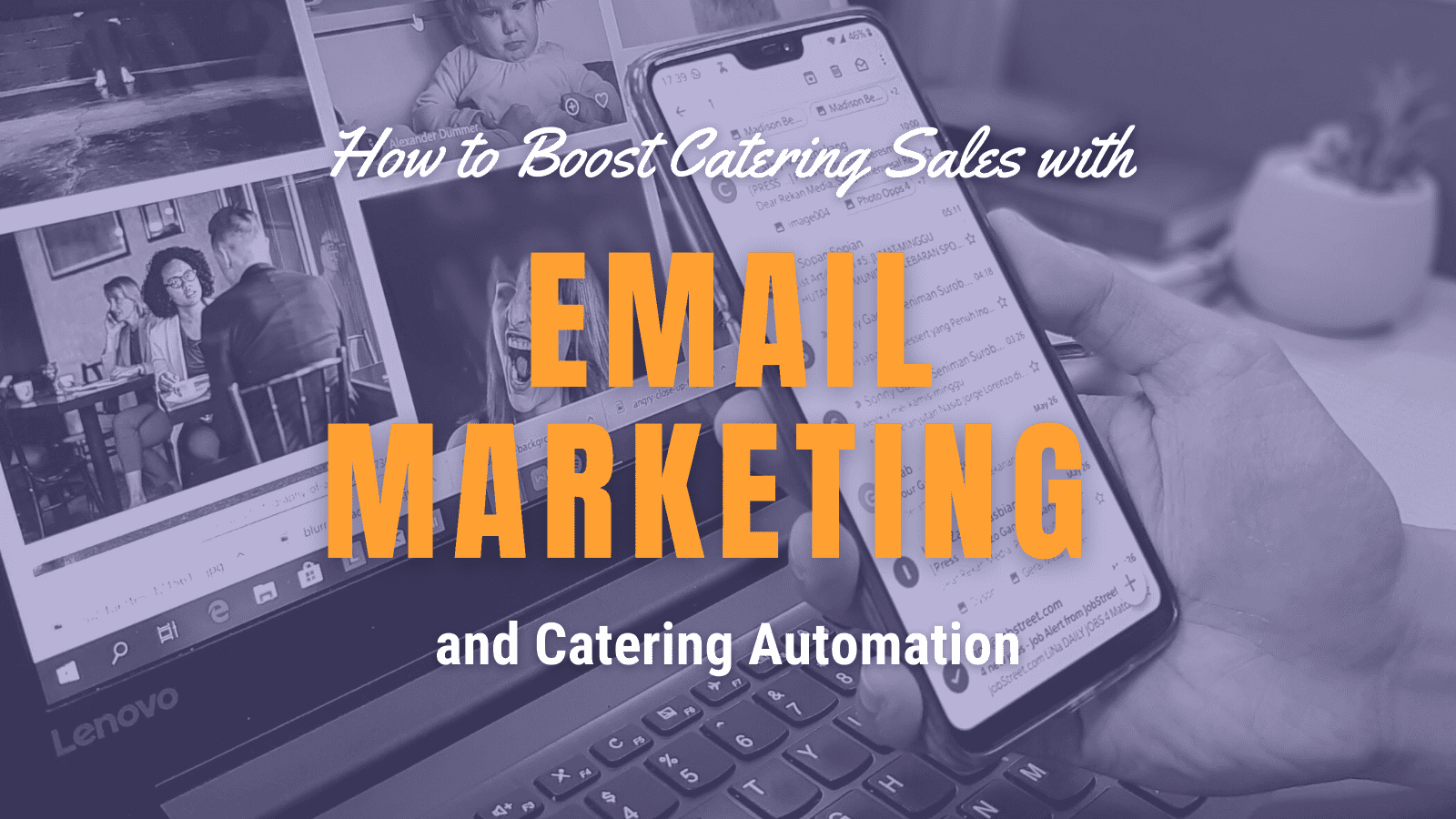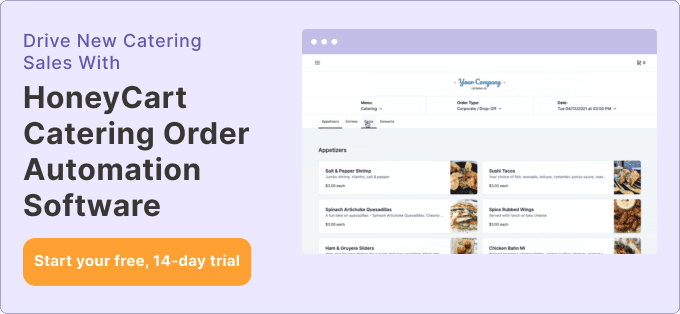In 1971, Ray Tomlinson sent the first-ever email.
His goal was to leave messages for people, not mailboxes. But little did he know that innocent act would become one of the most widely used forms of communication. Much less as a tool trusted to generate revenue for their businesses.
Today, email marketing ranks as the most effective form of digital marketing. It beats social media and SEO, making it a reliable way to nurture leads, build relationships and generate more sales (even for catering businesses).
But why should you care?
In our ever-competitive food industry, where restaurants are now vying with caterers for customers’ attention, email marketing, if done right, is an effective way to remain top of your customers’ minds.
So if you combine email with catering automation, you can arm your business with a surefire way to generate consistent catering sales.
If you’re wondering how to achieve all this, don’t worry.
That’s what you’re about to find out in this article. I’ll show you practical ways to combine email marketing and catering automation to grow your drop-off catering business.
Before we get into the thick of things, let’s briefly discuss…
How Email Marketing Works
If you have an active email address, I bet you receive nothing less than 10 – 15 emails every day.
While some may be work-related or transactional, most of them are from companies you subscribed to via their website, landing page, or social media.
And when you check the content of these emails, they are mostly:
- Promotional emails: promoting a special offer, discount codes, a new product, an ebook, or a webinar.
- Informational emails: to share news or information about the latest happenings
- Educational emails: educate you about their product or services or anything that you’ll likely find helpful.
Regardless of the type of email, their goal is to nurture (and eventually convert) you into a customer. And if you’re already a customer, to a repeat buyer and a brand advocate.
From what I described above, email marketing is the act of sending emails to promote, inform, engage, build relationships, and drive sales for your business.
Let’s explore the benefits of email marketing to catering businesses.
6 Benefits of Email Marketing to Your Catering Business
1. Increase Catering Sales
Without a doubt, having a list of people interested in receiving emails from you is a great way to get more catering sales.
Here’s why:
By opting into your email list, they permitted you to send emails to them, including promoting your catering services.
Remember, people buy from people they know, like, and trust. Email marketing helps you build trust with your subscribers.
And once you’ve built trust, they are more likely to buy. So, you can easily sell your catering services, promote your online menu, share helpful tips, give them discount offers, etc. As a result, you boost catering sales.
2. You Own Your Email List
Promoting your catering business on Instagram or other social media platforms is great. But what happens when these platforms change their policies or, worse, delete your account without prior notice?
It would have a detrimental effect on your business. In short, you could lose all your followers, which will decrease catering sales.
And the truth is, there’s nothing you can do about it as that audience was not yours to start with. They belonged to the social media platforms.
That’s why it makes sense to build your email list because you have control over it, and it’s not affected by any unfavorable policies. In other words, you own your email list, and nobody can take it away from you.
3. It’s Cost-effective
Another advantage of using email marketing to promote your catering business is that it’s cost-effective.
Unlike promoting your business on traditional marketing channels like flyers, billboards, radio, or newspapers, where you’ll pay more money to reach a limited number of people.
In short, research says email marketing has a 42x ROI. That is, for every $1 you spend, you get $42 in return. So it’s even more cost-effective than other forms of digital marketing like social media, SEO, or paid ads.
So, if you want to get more catering clients without breaking the bank, email marketing is for you.
4. Reach Prospects & Customers Directly
Why do most social media platforms, websites, or mobile apps ask you to sign up with an email address?
I’ll tell you.
It’s because they know it’s the easiest way to reach you directly. Email marketing allows you direct access to people who are most interested in your business.
Also, you’ll agree that sometimes life gets so busy that you forget to check your social media feed for days. Unfortunately, the same applies to a lot of people. As such, whenever you post on social media, they are more likely to miss it.
Most big companies know this.
That’s why they request your email address before signing up, so any vital information they send goes straight to your inbox.
What’s more, research shows 91% check their emails at least once a day. And more than 50% of consumers in the U.S. check their email more than ten times a day.
Judging by the above stats, you can see why email marketing helps to communicate with your prospects and customers directly.
5. Helps with Personalization & Segmentation
According to HubSpot research, marketers are sending 27% more emails than pre-coronavirus.
Why, you ask?
Because most businesses want to connect with their consumers on a personal and human level, and email marketing is the best way to get personal with them.
Joolz Joseph FCIM, an Email Marketing Consultant and Marketing Motivator agree:
“As consumers, we are looking for a more personal connection with brands, and finding ways to create that connection is key for marketers. Being genuinely interested in your customers will pay dividends long term.”
And there’s data to support this.
72% of consumers say they will only respond to personalized marketing messages. Also, 91% of consumers are more likely to spend money with businesses that offer personalized recommendations and offers.
In other words, customers appreciate when brands add that personal touch to their messaging to make it more relevant and targeted.
And one of the most effective ways to personalize emails is by segmenting your email list. That is, dividing your list into smaller groups based on specific criteria so you can send them relevant emails that will interest them.
For instance, you can have a separate list for prospects and another one for customers.
So instead of sending the same emails to all your subscribers, you can send customized emails to the list that will benefit the most. For instance, giving a discount to first-time customers. These kinds of emails will result in higher conversions and more catering sales.
6. Build Credibility & Develop Stronger Relationships With Customers
One mistake lots of businesses make with email marketing is constantly sending promotional emails. Unfortunately, this strategy is a recipe for failure.
You may have heard the saying: “People love to buy but don’t like being sold to.” What this means is constantly asking people to buy is a huge turnoff.
A better way to promote your catering business is to educate, entertain and inform your subscribers. This way, you’ll build credibility and develop long-lasting relationships with them.
And email marketing makes this process easy. Whenever your subscribers are ready to buy, you’ll be the first on their minds.
Now you know the benefits of email marketing to your catering business, let’s look at how to launch an email marketing campaign.
How to Launch a Catering Email Marketing Campaign
1. Choose an Email Service Provider (ESP)
When it comes to email marketing, one crucial thing you should know is that you can’t use your Yahoo or Gmail accounts to send bulk emails. That’s because they don’t have the proper infrastructure for email marketing.
And that’s where Email Service Providers come in.
As such, the first thing you need to do before you start email marketing is to choose an Email Service Provider.
It’s on an ESP platform you’ll:
- Add your email subscribers
- Create marketing campaigns
- Create engaging newsletter designs
- Send emails to your subscribers
- Track and measure email marketing performance
There are various ESPs to choose from. Popular examples are Mailchimp, Constant Contact, Aweber, Convertkit, SendinBlue, Mailjet, HubSpot, to name a few.
Some ESPs like Mailchimp, SendinBlue, and HubSpot, offer free plans. However, their free plans have certain limitations. While other ESPs will cost you at least $10 per month, depending on the number of subscribers you have or the volume of emails you send.
2. Build Your Email List
Ever heard of the saying: “there’s money in the list?”
It’s a popular slang among Internet marketers that means if you have an email list, you can monetize it over and over again.
However, one common mistake most marketers make is buying an email list. The truth is sending emails to people who didn’t subscribe or give you permission to email them is spam.
Moreso, you can only market to people that are interested in your catering services. I bet you delete emails or send them to spam from companies you didn’t subscribe to.
In other words, you must never purchase an email list. Instead, you have to build yours from scratch.
And how do you do that?
Let’s take a look at some practical ways:
1. Add an Opt-in Form to Your Website
Have you ever visited a website, and five seconds later or just when you are about to exit, a popup form displays asking you to input your email address in exchange for something valuable?
I bet you have.
It’s called a lead magnet. Think of it as an incentive or bribe you give people in exchange for their email address. Depending on your services, the incentive can be free cookbooks, video tutorials, templates, discount offers, etc.
You can also add the opt-in form to other visible places on your website like blog posts, homepage, or contact page.
Tools like OptinMonster, Leadpages, or SeedProd are great for creating opt-in forms on your website.
Here’s an example of an opt-in form we created with OptinMonster:
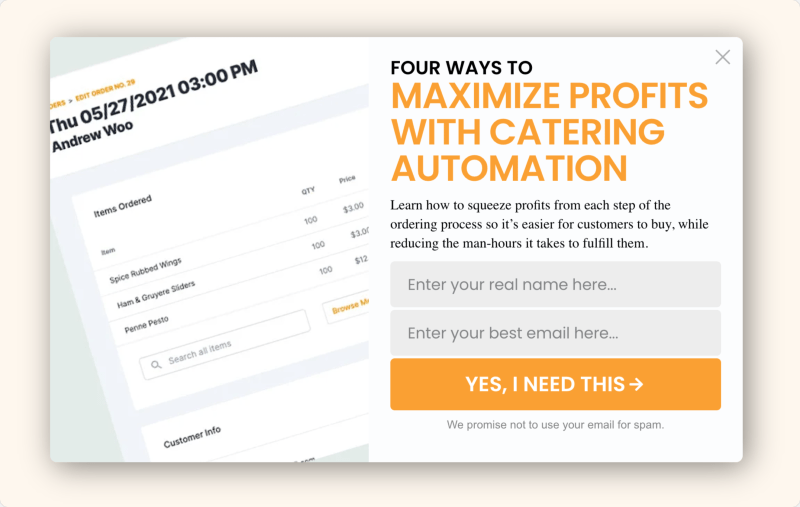
2. Encourage Your Social Media Followers to Join
Remember, I mentioned earlier that your social media followers are not yours. But you can convert them to subscribers by encouraging them to join your email list.
To do this, simply place a link to your opt-in form on your Facebook or Instagram bio. This way, anyone that clicks it will instantly join your email list.
Although some people may join willingly, others still need a reason to join.
Again, that’s where a lead magnet comes in. You can offer discount codes, cookbooks, tutorials, or templates on social media in exchange for their email address.
You can also run paid social media campaigns to reach more people and spread the word about your business in a short time.
But instead of asking them to make a purchase, simply give them something valuable in exchange for their email address.
3. Download Emails From Your Catering Software
You can quickly build your email list if you use catering order automation software like HoneyCart to process catering orders.
Here’s how:
Customers that you get from your website, social media, or referrals have to enter their emails before placing orders. Once you have their emails, you can easily download and upload them to your email service provider.
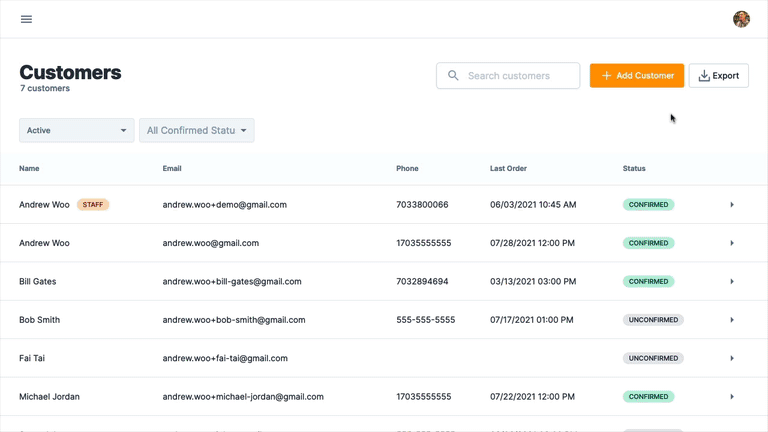
Sending information about your new menu offerings, special promotions, discount offers, or video tutorials to your customers via email is a great way to build long-lasting relationships with them.
As a result, they are more likely to become repeat customers and brand advocates.
This HoneyCart feature is what Chef Jolie, founder and Head Chef of Low Country Quisine, uses to increase catering sales.
In her words:
“When the customer orders on HoneyCart, they have to enter their email address. So we download those emails and use them for email marketing. When we want to run a promo, we go after the low-hanging fruit: you’ve been ordering from me, and I can reach out to say, “Hey, we’re having a sale, or we’re doing this promotion.”
3. Create & Send Engaging Email Marketing Content
Once you have a list of email subscribers, you are ready to start sending email campaigns.
And the key to being successful with email marketing is to ensure the content you send is engaging enough to convert subscribers to customers.
Now, you may be thinking: what kind of email should I send to my subscribers?
Not to worry, I’ve got you covered.
Here are some email content ideas you can send to your subscribers:
1. Welcome Email
When someone signs up to your email list, it means they are interested in your offer. As such, the first thing subscribers should receive when they join your email list is a welcome email.
A welcome email is an automated message sent to new subscribers. The goal is to show you are excited they subscribed, introduce your business, establish a relationship and tell them what to expect. In short, 74% of consumers expect a welcome email as soon as they subscribe.
Aleya Harris, an award-winning marketer and former chef and catering company owner, is the Owner of Flourish Marketing also emphasized the need to send a welcome email.
In her words:
“A sequence of personalized emails welcomes your new subscribers and creates a foundation to continue establishing trust and a relationship that will result in efficient sales.”
Also, it’s an opportunity to share whatever you may have promised them before they signed up, like a discount code, free cookbook, video tutorials, or templates.
2. Promote Your Online Catering Menu
If you often change your menu to include or remove certain items, your prospects and customers need to be aware. This way, they know what’s available and can easily place orders for their favorite dish.
What’s more, it’s an opportunity to introduce your customers to new recipe ideas or create special tasty meals for a limited number of people. It makes them feel part of your brand.
And with an online ordering software like HoneyCart, where you get access to a customized link, you can simply add this link to your online catering menu.
Anyone who clicks on it from their inbox will be taken straight to your online menu, where they can place their orders. This way, they don’t have to go through the inconveniences of calling or emailing you before ordering food.
3. Share Valuable Email Newsletters
Email marketing is not all about selling. It’s also an opportunity to share valuable content without asking your subscribers to buy anything from you.
As a caterer, you can share tips or tutorials about best kitchen practices or how to prepare special delicacies.
These kinds of emails are where you start to build a relationship with your subscribers, as they are essential to your overall marketing campaign.
What’s more, if you do this consistently and decide to sell cookbooks, templates, or any other product, you’ll have a list of people willing to buy from you.
Here’s an example of an email newsletter from Sugarsnap Catering:
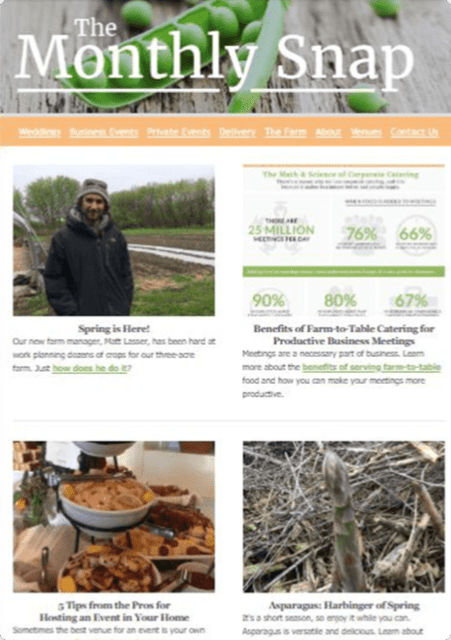
4. Send Holiday Offers
Holidays like Christmas, Easter, Valentine’s day, or Thanksgiving day are great opportunities to sell your catering services.
People who will organize small home or office parties will need the services of a drop-off caterer. So before any of these days, you can send newsletters reminding them that you are available to drop off mouthwatering meals at their parties.
4. Track and Measure Your Email Marketing Efforts
One of the best things about using an email service provider is tracking and measuring your email marketing efforts. This way, you can make informed decisions on where to improve to get better results.
Some key metrics to look out for when tracking your emails are:
- Open Rate: This shows the percentage of subscribers who opened your email. You calculated it by dividing the number of people who opened your email by the total number of recipients.
- Click-through rate: This is the percentage of subscribers who clicked a link in your email. You calculate it by the number of people that clicked on a link in your email divided by the total number of recipients.
- Unsubscribe rate: The number of people who unsubscribed divided by the total number of recipients.
- Bounce rate: The number of emails that failed to deliver divided by the number of emails sent. And there are two types.
- Soft bounces are due to temporary issues like the subscriber’s inbox being full.
- Hard bounces are due to permanent issues (e.g. an inactive email address).
Conclusion: Scale Your Business With Email Marketing and Catering Automation
Online marketing is the easiest and fastest way to get more customers and increase catering sales in today’s digital-first world. And email marketing remains a very integral part of it.
When combined with the power of catering automation, you are guaranteed to generate consistent sales for your business.
Because your subscribers will go from enjoying premium email content to placing orders for your tasty meals in just a few clicks instead of having to call or email you before ordering.
What’s more, by using catering software like HoneyCart to automate your catering business, you’ll save more time, save costs, increase efficiency and make the ordering process more convenient for customers.
This helps you compete with more prominent catering companies to attract customers.
Just as Abbey Duke, CEO of Sugarsnap Catering, found out when she started using HoneyCart:
“It automates mundane tasks to allow us to use our time as efficiently as possible. HoneyCart truly enables small caterers to compete with larger companies by having a really professional and easy-to-use online ordering system.”
Ready to see how it works?
Start with a free, 14-day trial right away. No credit card is required.

